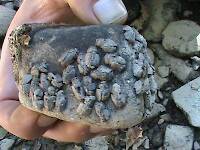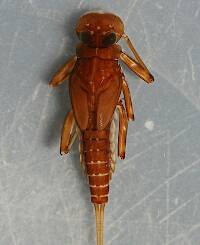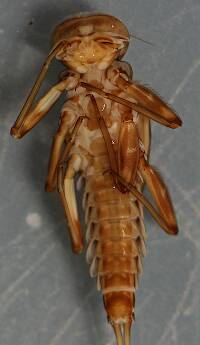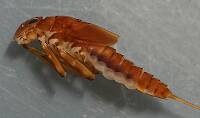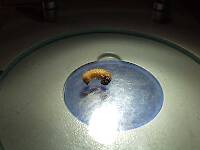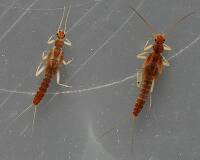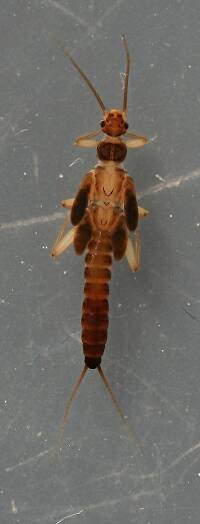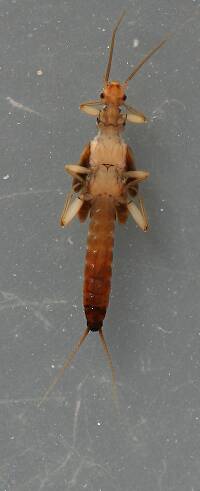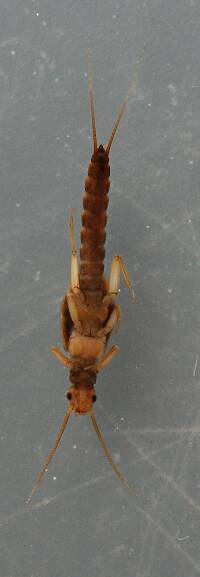
Salmonflies
Pteronarcys californica
The giant Salmonflies of the Western mountains are legendary for their proclivity to elicit consistent dry-fly action and ferocious strikes.
Featured on the forum

Nymphs of this species were fairly common in late-winter kick net samples from the upper Yakima River. Although I could not find a key to species of Zapada nymphs, a revision of the Nemouridae family by Baumann (1975) includes the following helpful sentence: "2 cervical gills on each side of midline, 1 arising inside and 1 outside of lateral cervical sclerites, usually single and elongate, sometimes constricted but with 3 or 4 branches arising beyond gill base in Zapada cinctipes." This specimen clearly has the branches and is within the range of that species.

Troutnut is a project started in 2003 by salmonid ecologist Jason "Troutnut" Neuswanger to help anglers and
fly tyers unabashedly embrace the entomological side of the sport. Learn more about Troutnut or
support the project for an enhanced experience here.
Spatsizi
Posts: 1
Posts: 1
Spatsizi on Sep 15, 2006September 15th, 2006, 3:09 pm EDT
Hello Jason - this is a fabulous site. Are you from Ithaca!
Anyway, I've been finding what I think are small mayfly larvae in a stream near here. How small can mayfly larvae get? And do they emerge in singles? The trout and shiners are sipping something fairly regularly.
I have a little 6 1/2 foot 3 weight, and I'm thinking of trying to find a nymph or fly that would be an imitation of these.
Anyway, I've been finding what I think are small mayfly larvae in a stream near here. How small can mayfly larvae get? And do they emerge in singles? The trout and shiners are sipping something fairly regularly.
I have a little 6 1/2 foot 3 weight, and I'm thinking of trying to find a nymph or fly that would be an imitation of these.
Troutnut on Sep 15, 2006September 15th, 2006, 3:22 pm EDT
Hi Spatsizi,
Yeah, I'm in Ithaca! I finished Cornell in January and I'm sticking around for a while before heading to grad school in Alaska next summer.
Mayfly larvae (nymphs, actually) can get just about microscopic, because they may have just hatched from the tiny egg, especially at this time of year. But if you're seeing trout sip something on the surface at this time of year, it's probably not mayfly nymphs, unless they're full-grown nymphs of a tiny mayfly species just about to emerge (2-4mm Tricorythodes mayflies might be around).
Which stream, and have you seen adult insects on the water when the trout are sipping? At this time of year the most likely culprit for that sort of thing would probably be flying ants. It sounds like you might need a dry fly instead of a nymph.
Yeah, I'm in Ithaca! I finished Cornell in January and I'm sticking around for a while before heading to grad school in Alaska next summer.
Mayfly larvae (nymphs, actually) can get just about microscopic, because they may have just hatched from the tiny egg, especially at this time of year. But if you're seeing trout sip something on the surface at this time of year, it's probably not mayfly nymphs, unless they're full-grown nymphs of a tiny mayfly species just about to emerge (2-4mm Tricorythodes mayflies might be around).
Which stream, and have you seen adult insects on the water when the trout are sipping? At this time of year the most likely culprit for that sort of thing would probably be flying ants. It sounds like you might need a dry fly instead of a nymph.
Jason Neuswanger, Ph.D.
Troutnut and salmonid ecologist
Troutnut and salmonid ecologist
Quick Reply
Related Discussions
Topic
Replies
Last Reply
0
Sep 26, 2020
by Millcreek
by Millcreek



